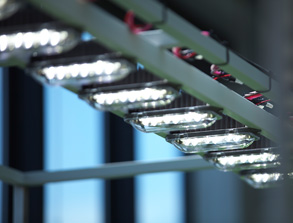-

-
At first glance it looks like nothing more than a simple, fine white powder. But appearances can be deceiving. This is titanium dioxide (TiO2) and it is the substance that has been the focus of Professor Akira Fujishima's pioneering research and defined his career as a chemist. It has also been used in an array of ways that continue to change the world for the better.
Fujishima is renowned for his discoveries, most prominent among them is the discovery that when exposed to light, TiO2 can split water into oxygen and hydrogen. His subsequent research and resulting applications have only served to boost his profile in scientific circles.
"Titanium dioxide is a very unique and interesting material. Even today it continues to be at the heart of photocatalysis research," says Fujishima with a hint of pride.
-
Fujishima's two principle discoveries were that sunlight in combination with TiO2 oxidizes water—breaking it into to oxygen and hydrogen—and later that TiO2 has a strong affinity for water, a characteristic technically known as superhydrophilicity.
"When I made the discovery, I was very impressed by the oxygen that I saw coming from the TiO2 because, essentially, I had been able to mimic photosynthesis. Like chlorophyll in plants I was using the power of the sun to break down water and create oxygen," says Fujishima.
His discovery made few headlines at first. Undeterred, Fujishima carried on, publishing his research in "Nature" in 1972 and the rest is history.
-

The timing of the publication was perfect: oil shocks that rocked the world thrust his research into the spotlight. His initial find and subsequent research has formed the foundation for a thriving body of research on photocatalysis.
An inveterate researcher, Fujishima has continued pressing ahead to pioneer and facilitate the discovery of new TiO2 applications. Over 40 years later his discovery continues to make waves.
TiO2 has been instrumental in the development of air and water purification technologies as well as self-cleaning, anti-fogging and anti-staining applications.
The most pervasive and perhaps the most straightforward example of TiO2 applications is that of self-cleaning buildings. Tiles and other surfaces coated with TiO2 stay clean thanks to the properties of the substance. Sunlight causes oxidation that breaks down grime while the superhydrophilicity of the substances causes the water to spread, washing surfaces clean. Air purifiers and anti-fog mirrors are two other popular applications.
"TiO2 can break down water, kill bacteria, and deodorize by getting rid of odors like that of tobacco or pets. It is truly an incredible substance," Fujishima says.
-


-
Currently, among photocatalysts, TiO2 is the most efficient in terms of photoactivity, stability and is also the least expensive.
The promise of TiO2 and Photocatalysis is great—and the same is true of the new TUS Photocatalysis International Research Center (PIRC). Opened in April 2013 and constructed at a cost of nearly 1 billion yen, the building is home to a growing team of researchers working on fundamental and applied photocatalysis research. The center is organized into three groups. A self-cleaning group that evaluates the performance of technologies using surfaces such as windows and walls; an artificial photosynthesis group that conducts experiments using sunlight; and an environmental cleanup group that researches ways to clean the environment with composite photocatalysts.
Photocatalysis is increasingly catching on around the world. And the scope for growth is great. While around 80 billion yen in TiO2 was used in Japan last year, use overseas amounted only to a quarter of this, according to Fujishima.
"I am sure the future will bring a range of new applications," he says.
-
While a wealth of applications already exist, Fujishima has not sat on his laurels and remains excited about more challenging applications that might be on the horizon. In particular, he has high hopes for medical and health applications.
TiO2 has been shown to kill not only bacteria, but also viruses and cancer, he says. At the same time, indoor uses of TiO2 could greatly improve quality of life but also pose a particular challenge.
"Indoor applications such as wallpaper are what we are most behind on. Indoor light is visible light and TiO2 needs ultraviolet light to do what it does," he says. Currently, the PIRC is conducting research with government funding to develop a photocatalytic technology that is more sensitive to visible light.
-

Other areas of attention are energy and hydroponic agriculture. Finding an efficient and affordable way to split water and produce hydrogen would have immense implications for the world. Meanwhile, research with hydroponic agriculture is showing that using TiO2 to keep the plant water clean results in better plant growth.
To help further photocatalytic technology and improve the world TUS and Fujishima are committed to continuing to bring talented researchers from overseas.
"We plan to increase the ranks of foreign researchers and students each year and a dormitory for them is to be built within the year," he says. This is all part of the direction that TUS is charting toward the future.
"We are entering a global age requiring a more global approach. Photocatalysis is an area of research with immense promise and the more international cooperation that we can achieve, the better," Fujishima says.



Director of the Photocatalysis International Research Center
Professor Fujishima is known for significant contributions to the discovery and research of photo catalytic and superhydrophilic properties of titanium dioxide (TiO2). Professor Fujishima has been the recipient of many prestigious awards and honors.



